Papers by José García-arrarás
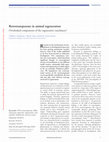
Mobile genetic elements, Sep 1, 2012
R esearch on the involvement of retroelements in developmental processes has been gaining momentu... more R esearch on the involvement of retroelements in developmental processes has been gaining momentum recently; however, most of the studies published so far have been focused on embryonic development. This commentary presents two recent papers, which document significant changes in transcriptional activity of retroelements in two different model systems, salamander limb regeneration and regeneration of radial organs in the sea cucumber Holothuria glaberrima. We hypothesize that transcriptional activity of the retrotransposons can be specifically controlled by the host and may play some hitherto unrecognized role in regeneration. Regeneration represents a unique biological phenomenon of re-initiation of developmental processes in animals in response to various kinds of traumatic injuries. The ability to regrow injured body parts is widely, but unevenly represented in the animal kingdom. Therefore, regenerative biology, as a field, has benefited from studies on animals, such as salamanders, echinoderms, planarians and coelenterates, that show amazing feats of regeneration not commonly found in classical animal models such as mice, Drosophila or C. elegans. Understanding gene regulatory mechanisms driving post-traumatic tissue re-growth in these regeneration-competent animals is important for two reasons. First, on a theoretical level, it contributes to our knowledge of fundamental principles of regeneration as a developmental phenomenon, its evolution and relationships with embryogenesis. A related, but more practical reason, is that the research Retrotransposons in animal regeneration Overlooked components of the regenerative machinery?
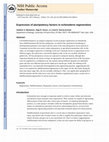
Cell and Tissue Research, Dec 3, 2014
Cell dedifferentiation is an integral component of post-traumatic regeneration in echinoderms. Si... more Cell dedifferentiation is an integral component of post-traumatic regeneration in echinoderms. Since dedifferentiated cells become multipotent, we asked if this spontaneous broadening of developmental potential is associated with the action of the same pluripotency factors (known as Yamanaka factors) that were used to induce pluripotency in specialized mammalian cells. In this study, we investigate expression of orthologs of the four Yamanaka factors in regeneration of two different organs, the radial nerve cord and the digestive tube, in the sea cucumber Holothuria glaberrima. All four pluripotency factors are expressed in uninjured animals, although their expression domains do not always overlap. In regeneration, the expression levels of the four genes were not regulated in a coordinated way, but, instead, showed different dynamics for individual genes and also were different between the radial nerve and the gut. SoxB1, the ortholog of the mammalian Sox2, was drastically downregulated in the regenerating intestine, suggesting that this factor is not required for dedifferentiation/regeneration in this organ. On the other hand, during the early post-injury stage, Myc, the sea cucumber ortholog of c-Myc, was significantly upregulated in both the intestine and the radial nerve cord, and is, therefore, hypothesized to play a central role in dedifferentiation/regeneration of various tissue types.

BMC Developmental Biology, Oct 18, 2007
Background: All animals possess some type of tissue repair mechanism. In some species, the capaci... more Background: All animals possess some type of tissue repair mechanism. In some species, the capacity to repair tissues is limited to the healing of wounds. Other species, such as echinoderms, posses a striking repair capability that can include the replacement of entire organs. It has been reported that some mechanisms, namely extracellular matrix remodeling, appear to occur in most repair processes. However, it remains unclear to what extent the process of organ regeneration, particularly in animals where loss and regeneration of complex structures is a programmed natural event, is similar to wound healing. We have now used the sea cucumber Holothuria glaberrima to address this question. Results: Animals were lesioned by making a 3-5 mm transverse incision between one of the longitudinal muscle pairs along the bodywall. Lesioned tissues included muscle, nerve, water canal and dermis. Animals were allowed to heal for up to four weeks (2, 6, 12, 20, and 28 days postinjury) before sacrificed. Tissues were sectioned in a cryostat and changes in cellular and tissue elements during repair were evaluated using classical dyes, immmuohistochemistry and phalloidin labeling. In addition, the temporal and spatial distribution of cell proliferation in the animals was assayed using BrdU incorporation. We found that cellular events associated with wound healing in H. glaberrima correspond to those previously shown to occur during intestinal regeneration. These include: (1) an increase in the number of spherule-containing cells, (2) remodeling of the extracellular matrix, (3) formation of spindle-like structures that signal dedifferentiation of muscle cells in the area flanking the lesion site and (4) intense cellular division occurring mainly in the coelomic epithelium after the first week of regeneration. Conclusion: Our data indicate that H. glaberrima employs analogous cellular mechanisms during wound healing and organ regeneration. Thus, it is possible that regenerative limitations in some organisms are due either to the absence of particular mechanisms associated with repair or the inability of activating the repair process in some tissues or stages.

BMC Developmental Biology, Nov 29, 2010
Background: The proper balance of cell division and cell death is of crucial importance for all k... more Background: The proper balance of cell division and cell death is of crucial importance for all kinds of developmental processes and for maintaining tissue homeostasis in mature tissues. Dysregulation of this balance often results in severe pathologies, such as cancer. There is a growing interest in understanding the factors that govern the interplay between cell death and proliferation under various conditions. Survivin and mortalin are genes that are known to be implicated in both mitosis and apoptosis and are often expressed in tumors. Results: The present study takes advantage of the ability of the sea cucumber Holothuria glaberrima Selenka, 1867 (Holothuroidea, Aspidochirota) to discard its viscera and completely regrow them. This visceral regeneration involves an extensive expression of survivin and mortalin transcripts in the gut mesothelium (the outer tissue layer of the digestive tube), which coincides in time with drastic de-differentiation and a burst in cell division and apoptosis. Double labeling experiments (in situ hybridization combined with TUNEL assay or with BrdU immunohistochemistry) suggest that both genes support cell proliferation, while survivin might also be involved in suppression of the programmed cell death. Conclusions: Visceral regeneration in the sea cucumber H. glaberrima is accompanied by elevated levels of cell division and cell death, and, moreover, involves expression of pro-cancer genes, such as survivin and mortalin, which are known to support proliferation and inhibit apoptosis. Nevertheless, once regeneration is completed and the expression pattern of both genes returns to normal, the regrown digestive tube shows no anomalies. This strongly suggests that sea cucumbers must possess some robust cancer-suppression mechanisms that allow rapid re-growth of the adult tissues without leading to runaway tumor development.
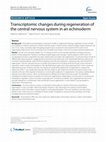
BMC Genomics, 2014
Background: Echinoderms are emerging as important models in regenerative biology. Significant amo... more Background: Echinoderms are emerging as important models in regenerative biology. Significant amount of data are available on cellular mechanisms of post-traumatic repair in these animals, whereas studies of gene expression are rare. In this study, we employ high-throughput sequencing to analyze the transcriptome of the normal and regenerating radial nerve cord (a homolog of the chordate neural tube), in the sea cucumber Holothuria glaberrima. Results: Our de novo assembly yielded 70,173 contigs, of which 24,324 showed significant similarity to known protein-coding sequences. Expression profiling revealed large-scale changes in gene expression (4,023 and 3,257 up-regulated and down-regulated transcripts, respectively) associated with regeneration. Functional analysis of sets of differentially expressed genes suggested that among the most extensively over-represented pathways were those involved in the extracellular matrix (ECM) remodeling and ECM-cell interactions, indicating a key role of the ECM in regeneration. We also searched the sea cucumber transcriptome for homologs of factors known to be involved in acquisition and/or control of pluripotency. We identified eleven genes that were expressed both in the normal and regenerating tissues. Of these, only Myc was present at significantly higher levels in regeneration, whereas the expression of Bmi-1 was significantly reduced. We also sought to get insight into which transcription factors may operate at the top of the regulatory hierarchy to control gene expression in regeneration. Our analysis yielded eleven putative transcription factors, which constitute good candidates for further functional studies. The identified candidate transcription factors included not only known regeneration-related genes, but also factors not previously implicated as regulators of post-traumatic tissue regrowth. Functional annotation also suggested that one of the possible adaptations contributing to fast and efficient neural regeneration in echinoderms may be related to suppression of excitotoxicity. Conclusions: Our transcriptomic analysis corroborates existing data on cellular mechanisms implicated in regeneration in sea cucumbers. More importantly, however, it also illuminates new aspects of echinoderm regeneration, which have been scarcely studied or overlooked altogether. The most significant outcome of the present work is that it lays out a roadmap for future studies of regulatory mechanisms by providing a list of key candidate genes for functional analysis.
The FASEB Journal, Mar 1, 2008

The FASEB Journal, 2014
Holothuria glaberrima exhibits the capacity to regenerate body parts after injury or loss. This a... more Holothuria glaberrima exhibits the capacity to regenerate body parts after injury or loss. This ability is mediated by an initial blastemal formation which requires proliferation and reorganization of precursor cells. Accordingly, various molecules play key roles in different aspects of the regeneration of a body part. The use of microarrays and high‐throughput sequencing lead our laboratory to identify a series of new molecules associated to different processes of regeneration. Such is the case for the protein Orpin.Based on an EST database, we found that Orpin gene is over expressed at early stages of intestinal regeneration. Its expression occurs concomitantly with remodeling of the extracellular matrix. Also, another isoform was identified and both sequences were present in libraries from regenerating nerve and intestinal tissues. The characterization between those sequences indicates that both encode two EF‐hand motifs. Unlike other known calcium binding proteins, they exhibit ...
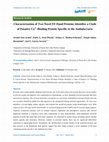
In recent years, transcriptomic databases have become one of the main sources for protein discove... more In recent years, transcriptomic databases have become one of the main sources for protein discovery. In our studies of nervous system and digestive tract regeneration in echinoderms, we have identified several transcripts that have attracted our attention. One of these molecules corresponds to a previously unidentified transcript (Orpin) from the sea cucumberHolothuria glaberrimathat appeared to be upregulated during intestinal regeneration. We have now identified a second highly similar sequence and analyzed the predicted proteins using bioinformatics tools. Both sequences have EF-hand motifs characteristic of calcium-binding proteins (CaBPs) and N-terminal signal peptides. Sequence comparison analyses such as multiple sequence alignments and phylogenetic analyses only showed significant similarity to sequences from other echinoderms or from hemichordates. Semi-quantitative RT-PCR analyses revealed that transcripts from these sequences are expressed in various tissues including mus...

Adult neurogenesis, generation of new functional cells in the mature central nervous system (CNS)... more Adult neurogenesis, generation of new functional cells in the mature central nervous system (CNS), has been documented in a number of diverse organisms, ranging from humans to invertebrates. However, the origin and evolution of this phenomenon is still poorly understood for many of the key phylogenetic groups. Echinoderms are one such phylum, positioned as a sister group to chordates within the monophyletic clade Deuterostomia. They are well known for the ability of their adult organs, including the CNS, to completely regenerate after injury. Nothing is known, however, about production of new cells in the nervous tissue under normal physiological conditions in these animals. In this study, we show that new cells are continuously generated in the mature radial nerve cord (RNC) of the sea cucumber Holothuria glaberrima. Importantly, this neurogenic activity is not evenly distributed, but is significantly more extensive in the lateral regions of the RNC than along the midline. Some of ...

BMC developmental biology, Jan 30, 2015
Adult echinoderms can completely regenerate major parts of their central nervous system even afte... more Adult echinoderms can completely regenerate major parts of their central nervous system even after severe injuries. Even though this capacity has long been known, the molecular mechanisms that drive fast and complete regeneration in these animals have remained uninvestigated. The major obstacle for understanding these molecular pathways has been the lack of functional genomic studies on regenerating adult echinoderms. Here, we employ RNA interference-mediated gene knockdown to characterize the role of Myc during the early (first 48 hours) post-injury response in the radial nerve cord of the sea cucumber Holothuria glaberrima. Our previous experiments identified Myc as the only pluripotency-associated factor, whose expression significantly increased in the wounded CNS. The specific function(s) of this gene, however, remained unknown. Here we demonstrate that knockdown of Myc inhibits dedifferentiation of radial glia and programmed cell death, the two most prominent cellular events th...

BMC genomics, Jan 12, 2014
Echinoderms are emerging as important models in regenerative biology. Significant amount of data ... more Echinoderms are emerging as important models in regenerative biology. Significant amount of data are available on cellular mechanisms of post-traumatic repair in these animals, whereas studies of gene expression are rare. In this study, we employ high-throughput sequencing to analyze the transcriptome of the normal and regenerating radial nerve cord (a homolog of the chordate neural tube), in the sea cucumber Holothuria glaberrima. Our de novo assembly yielded 70,173 contigs, of which 24,324 showed significant similarity to known protein-coding sequences. Expression profiling revealed large-scale changes in gene expression (4,023 and 3,257 up-regulated and down-regulated transcripts, respectively) associated with regeneration. Functional analysis of sets of differentially expressed genes suggested that among the most extensively over-represented pathways were those involved in the extracellular matrix (ECM) remodeling and ECM-cell interactions, indicating a key role of the ECM in re...
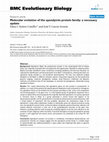
Bmc Evolutionary Biology, 2007
Background: Ependymin (Epd), the predominant protein in the cerebrospinal fluid of teleost fishes... more Background: Ependymin (Epd), the predominant protein in the cerebrospinal fluid of teleost fishes, was originally associated with neuroplasticity and regeneration. Ependymin-related proteins (Epdrs) have been identified in other vertebrates, including amphibians and mammals. Recently, we reported the identification and characterization of an Epdr in echinoderms, showing that there are ependymin family members in non-vertebrate deuterostomes. We have now explored multiple databases to find Epdrs in different metazoan species. Using these sequences we have performed genome mapping, molecular phylogenetic analyses using Maximum Likelihood and Bayesian methods, and statistical tests of tree topologies, to ascertain the phylogenetic relationship among ependymin proteins. Results: Our results demonstrate that ependymin genes are also present in protostomes. In addition, as a result of the putative fish-specific genome duplication event and posterior divergence, the ependymin family can be divided into four groups according to their amino acid composition and branching pattern in the gene tree: 1) a brain-specific group of ependymin sequences that is unique to teleost fishes and encompasses the originally described ependymin; 2) a group expressed in non-brain tissue in fishes; 3) a group expressed in several tissues that appears to be deuterostome-specific, and 4) a group found in invertebrate deuterostomes and protostomes, with a broad pattern of expression and that probably represents the evolutionary origin of the ependymins. Using codon-substitution models to statistically assess the selective pressures acting over the ependymin protein family, we found evidence of episodic positive Darwinian selection and relaxed selective constraints in each one of the postduplication branches of the gene tree. However, purifying selection (with among-site variability) appears to be the main influence on the evolution of each subgroup within the family. Functional divergence among the ependymin paralog groups is well supported and several amino acid positions are predicted to be critical for this divergence. Conclusion: Ependymin proteins are present in vertebrates, invertebrate deuterostomes, and protostomes. Overall, our analyses suggest that the ependymin protein family is a suitable target to experimentally test subfunctionalization in gene copies that originated after gene or genome duplication events.

Cell and Tissue Research, 2014
Cell dedifferentiation is an integral component of post-traumatic regeneration in echinoderms. Si... more Cell dedifferentiation is an integral component of post-traumatic regeneration in echinoderms. Since dedifferentiated cells become multipotent, we asked if this spontaneous broadening of developmental potential is associated with the action of the same pluripotency factors (known as Yamanaka factors) that were used to induce pluripotency in specialized mammalian cells. In this study, we investigate expression of orthologs of the four Yamanaka factors in regeneration of two different organs, the radial nerve cord and the digestive tube, in the sea cucumber Holothuria glaberrima. All four pluripotency factors are expressed in uninjured animals, although their expression domains do not always overlap. In regeneration, the expression levels of the four genes were not regulated in a coordinated way, but, instead, showed different dynamics for individual genes and also were different between the radial nerve and the gut. SoxB1, the ortholog of the mammalian Sox2, was drastically downregulated in the regenerating intestine, suggesting that this factor is not required for dedifferentiation/regeneration in this organ. On the other hand, during the early post-injury stage, Myc, the sea cucumber ortholog of c-Myc, was significantly upregulated in both the intestine and the radial nerve cord, and is, therefore, hypothesized to play a central role in dedifferentiation/regeneration of various tissue types.

Mechanisms of Regeneration, 2014
We provide an integrative view of mechanisms that enable regeneration of the digestive tube in va... more We provide an integrative view of mechanisms that enable regeneration of the digestive tube in various animal models, including vertebrates, tunicates, echinoderms, insects, and flatworms. Two main strategies of regeneration of the endodermal luminal (mucosal) epithelium have evolved in metazoans. One of them involves proliferation of resident epithelial cells, while the other relies on recruitment of cells from extramucosal sources. In any of these two scenarios, either pluri-/ multipotent stem cells or specialized differentiated cells can be used as the starting material. Posttraumatic visceral regeneration shares some common mechanisms with normal embryonic development as well as with organ homeostatic maintenance, but there are signaling pathways and/or cellular pools that are specific to the regenerative phenomena. Comparative analysis of the literature suggests that mammals share with spontaneously regenerating animals many of the regeneration-related adaptations and are able to efficiently repair components of their digestive tube at the level of individual tissues, but fail to do so at the whole-organ scale. We review what might cause this failure in the context of the current state of knowledge about various regenerative models. If the latent capacity for regeneration persists […], then the restoration of its overt expression should be possible if the mechanisms of its inhibition could be discovered and eventually rendered ineffectual Richard Goss (1992)

Physiological Genomics, 2007
Repair and regeneration are key processes for tissue maintenance, and their disruption may lead t... more Repair and regeneration are key processes for tissue maintenance, and their disruption may lead to disease states. Little is known about the molecular mechanisms that underline the repair and regeneration of the digestive tract. The sea cucumber Holothuria glaberrima represents an excellent model to dissect and characterize the molecular events during intestinal regeneration. To study the gene expression profile, cDNA libraries were constructed from normal, 3-day, and 7-day regenerating intestines of H. glaberrima. Clones were randomly sequenced and queried against the nonredundant protein database at the National Center for Biotechnology Information. RT-PCR analyses were made of several genes to determine their expression profile during intestinal regeneration. A total of 5,173 sequences from three cDNA libraries were obtained. About 46.2, 35.6, and 26.2% of the sequences for the normal, 3-days, and 7-days cDNA libraries, respectively, shared significant similarity with known seque...
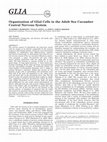
Glia, 2010
The nervous system of echinoderms has long been considered too unique to be directly comparable t... more The nervous system of echinoderms has long been considered too unique to be directly comparable to the nervous system of other Deuterostomia. Using two novel monoclonal antibodies in combination with epifluorescence, confocal, and electron microscopy, we demonstrate here that the central nervous system of the sea cucumber Holothuria glaberrima possesses a major non‐neuronal cell type, which shares striking similarities with the radial glia of chordates. The basic features in common include (a) an elongated shape, (b) long radial processes, (c) short lateral protrusions branching off the main processes and penetrating into the surrounding neuropile, (d) prominent orderly oriented bundles of intermediate filaments, and (e) ability to produce Reissner's substance. Radial glia account for the majority of glia cells in echinoderms and constitutes more than half of the total cell population in the radial nerve cord and about 45% in the circumoral nerve ring. The difference in glia cel...
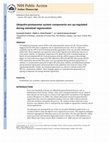
genesis, 2012
The ubiquitin proteasome system (UPS) is the main proteolytic system of cells. Recent evidence su... more The ubiquitin proteasome system (UPS) is the main proteolytic system of cells. Recent evidence suggests that the UPS plays a regulatory role in regeneration processes. Here we explore the possibility that the UPS is involved during intestinal regeneration of the sea cucumber Holothuria glaberrima. These organisms can regenerate most of their digestive tract following a process of evisceration. Initially, we identified components of H. glaberrima UPS, including sequences for Rpn10, β3 and ubiquitin-RPL40. Predicted proteins from the mRNA sequences showed high degree of conservation that ranged from 60% (Rpn10) to 98% (Ub-RPL40). Microarrays and RT-PCR experiments showed that these genes were up-regulated during intestinal regeneration. In addition, we demonstrated expression of alpha 20S proteasome subunits and ubiquitinated proteins during intestinal regeneration and detected them in the epithelium and connective tissue of the regenerating intestine. Finally, the intestinal regeneration was altered in animals treated with MG132, a proteasome inhibitor. These findings support our contention that proteasomes are playing an important role during intestinal regeneration.

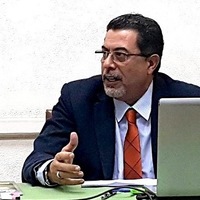


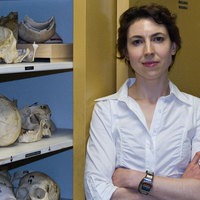


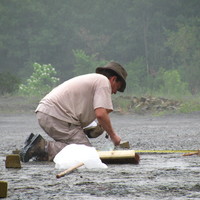

Uploads
Papers by José García-arrarás